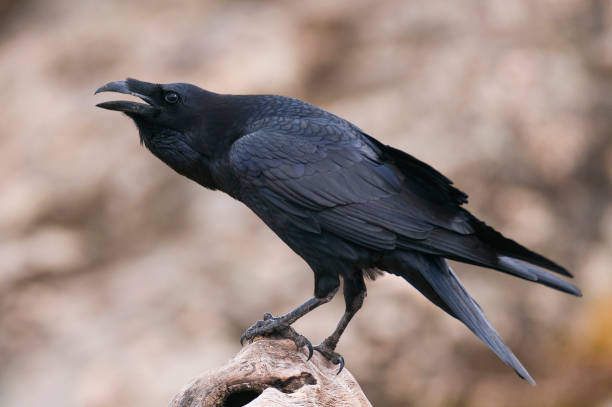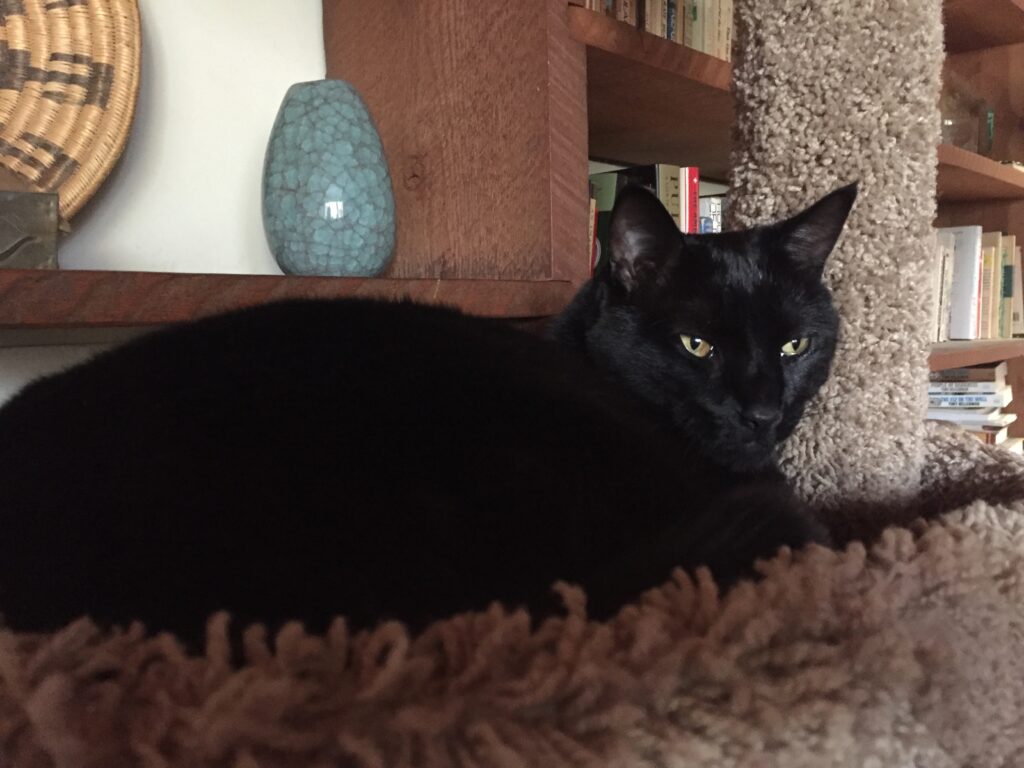I was doing laundry when I heard a raven squawking with an urgency I had never heard. We have many ravens in the neighborhood, and they are big talkers, but this message was a new one. I went to the window and saw it on a low branch about eye level. It was scolding, cursing, berating, reading the riot act to someone or something on the ground, head lunging forwarding, eye laser-focused. A snake, I thought. That is my fallback threat, so I cautiously headed for the back door to get a better look. As I approached, I saw the door was already ajar and stepped outside. The raven was raising a ruckus because our black indoor cat Bennie had escaped and was on the ground below the raven. He was hunched close to the ground, ears back, taking his scolding. I was struck by the two solid black creatures in relationship. Bennie had been headed for the fence, on the other side of which were coyotes, hawks, snakes, and more, and the raven had turned him back. He scurried back into the house and the crisis was over.


I know that ravens and crows, the whole corvid family of birds, are really smart. They can perform intricate tasks, they can recognize humans and keep track of their doings. There are fascinating stories in the research literature of ravens and crows that have returned lost items to the right person, have created tools to retrieve food, and have passed on information about dangerous people (like lab scientists on a university campus) to their offspring and their offspring. And apparently they know when a cat belongs in the house and not outside, and how to effectuate getting the cat back inside. There is no doubt in my mind that the bird was stopping Bennie in his tracks and alerting me to come and retrieve the escapee. I thanked it profusely, and I believe it understood.
This gets me thinking about how we are observed by non-human creatures more than we will ever know. There is an amazing documentary movie, “The Velvet Queen,” about two photographers who go to Tibet to photograph the famously elusive Snow Leopard. One of their most significant conclusions is that they were being watched by many more creatures than they realized. There is an irony there: they are searching for something almost impossible to find, and they are being seen by many animals (maybe the Snow Leopard in fact) that they never see.

We probably see a fraction of what sees us… or smells us. Our noses are so inferior to that dog, bear, wildcat that may be nearby. Our eyesight so inferior to that hawk, eagle, raven. Our hearing so inferior to that rabbit that has frozen just feet away, camouflaged in the brush. We blunder along – whether through our neighborhood or the wilderness – announcing ourselves to receptive ears, eyes and noses. It may seem creepy, but I find it comforting to know that there are those watching me, maybe watching out for me, at least curious about me. They don’t need to confront or announce themselves. They let me go on my way. It’s a relationship, a strange one-sided one, where it is their option to connect or not with me. And I know that if they have a message for me, they know how to get my attention.


Once again, the teachings of don Juan remind us to be aware of our surroundings and the inate intelligence of non-humans. Your story reminds me of the coyote who, while I was trout fishing a stream, came out of his den, growled, and then rose up on his hind feet and did a dance for me… for several minutes – out of nowhere! Like your friend the raven, then he was gone. It was pure magic that has stayed with me for many years. How lucky we are when we notice who’s noticing us.
That is an incredible story. I think it’s going to stick with me for a long time, even hearing it second hand. Thanks, John!
Well Lucy, don’t I know it? And isn’t it tragic that creatures of all kinds are not treated with the respect they deserve? It’s a misunderstood understanding from the cave men – well, way before that. perhaps. On a major level, the way American’s (in particular, and often) deal with their so called ‘pets’ is just a huge lapse in intelligence. Never mind birds, moles, chipmunks, mice – and probably their children too.
Have you read about Finland and how they deal with people with Alzheimers? They make villages for them. Place they can live and sleep and walk around and shop and talk to each other. However ‘out of it. they might be.
I’m an immigrant. I was a British person born in India after the Second World War. I got myself over the pond when I was twenty years old and I’ve been here ever since. I wanted to be here, in America. It seemed like a grand place to me.
In decline, I’d say. Sadly.
Oh well. Topsy Turvey world right now. Too many people just trying to survive, never mind thinking about other beings, How about all those loved creatures from secure houses abandoned in the Ukraine. Not, of course, to forget Texas right now
Great sadness.
Love to. you and Roberto. We will meet again one day. Myv.
Myfanwy Phillips. Northern New Hamshire.
Ah, Myv, so good to hear from you. And speaking of pets, any dog that has wandered into your life has been very lucky indeed — not only well cared for of course, but also respected and appreciated. And that is fascinating about the Alzheimers Village in Finland. Finland also regularly wins the “happiest country” poll, although I was in Sweden a few years ago when the results came out, Finland #1 again, and a Swedish person I was talking to said, “well, of course, Finland comes out on top — their expectations are so low.” We are funny creatures!
Lovely one! And Bennie sure learned a lesson. My old cat China was up very high in a tree in the bosque once and wouldn’t/couldn’t get down. Two crows (or ravens?) were watching my antics. Then they just swooped down at her and she scurried down the tree to safety.
Great story! Thanks, Lucy.
Loved this story! Not only are they watching us, they are helping us if we will only pay attention. I recently finished an art work named Animals of the Six Directions: Eagle, Badger, Wolf, Puma, Bear, Mole. Each is carved from reclaimed wood gathered in Galisteo and sport bead and twine ornaments. Adapted from southwestern indigenous traditions which I hope to honor with this piece. The ever worrisome “hitch in my giddy-up” being the question of perceived or actual cultural appropriation.
Thanks, Laurie. I’m sure your animals are beautiful, but it’s hard to know when appreciation drifts into appropriation. (see my blog last month https://lucymoore.com/cultural-appreciation/) I would suggest checking with some Native friends for their reactions.
Lucy — This is just marvelous, as your blogs usually are. The editorial board of Peace and Planet News (of which I am a member) would like permission to reprint it in a forthcoming issue. Please let me know if this would be all right. Thanks.
Of course, I would be honored. Thank you, Ken.
Thank you very much.
You’re (always!) welcome.
Since I’ve been a (an avid) reader of your blog, Lucy, I’ve looked forward to the 1st of the month like never before. Your observations give me new things to appreciate.
There’s a crow, a very acrobatic one, who comes regularly to dangle, big black wings flapping, and snatch a snack at one of my suet feeders—always the same feeder. I hope he knows I cheer him on.
I’m so glad I have made the first of the month a bright spot for you! And love the image of that show-off crow — you know it’s all for your benefit.
Thank you Lucy, this beautiful post fits in to what I am at the moment reading :ARE WE SMART ENOUGH TO KNOW HOW SMART ANIMALS ARE ?, by Frans de Wall with a lead in by my hero E O Wilson.
I am also reminded of what a guide in Belize/Guatamala told me once after many hours and days walking and searching the rain forest when I complained that I still had not seen a Jaguar. He said, “Don’t worry. Many have seen you.”
Jan, that is such a great story from Central America. Thank you.
A friend of mine here in Santa Fe was in a Buddhist-type retreat during which he lived completely by himself in the wilderness for 12 years. After a few years of this solo existence in nature, the wild animals and birds befriended him and accepted him into their natural world. He has told me amazing stories about their interactions.
Thanks, David, for the tantalizing trailer. But now I WANT TO HEAR THOSE STORIES!! Can you share with us?